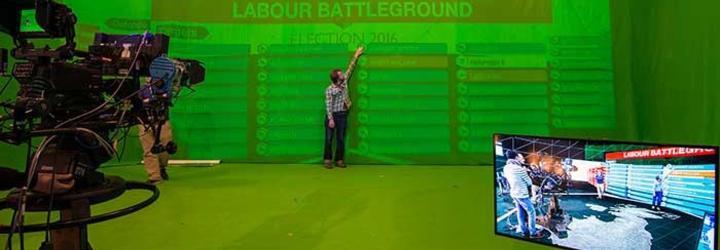
PRG XL Video Supplies Specialist Video Projection for BBC Live Local Election Coverage
On 7th May, the BBC aired its special programming for the election of local councils and Police Commissioners, as well as the election of the Mayor of London. Coverage of the election results included a special type of projection technology which was supported with video projectors from PRG XL Video.
The stereoscopic projection technology used by the BBC is what enables presenter Jeremy Vine to move around the studio and point out specific pieces of information within the projected, semi-transparent screens without the projection landing on the presenter himself. To the viewer the information is floating in the studio and the presenter is able to interact with it.
The technology behind this has been developed and refined over more than a decade.
Originally invented in Japan by a company called NHK in around 2001, the concept was known as invisible light. It was achieved by placing a specially developed LED screen in front of a conventional projector. The screen had a fast enough refresh rate that it allowed projection when the CCD camera shutter was closed, so the presenter could see the projection, and turn off the projection when the camera shutter is open.
To the presenter, the projection appeared to be half brightness at 50Hz. To the camera, there is no projection visible, but the whole image is slightly darker than usual.
The team at the BBC, including technical project manager, Danny Popkin, saw the invisible light system and believed it could be a useful presenter aid, however the cost of manufacturing the specialist LCD screen was prohibitive, so they looked for alternative options.
To achieve a similar effect, the BBC’s research and development department developed a mechanical shutter system, and by synchronising this to the camera, it created the same effect as NHK’s system. The downside was that it was rather noisy which is not ideal for television.
With the advent of digital light processing (DLP) projectors which could run at 100Hz, it became apparent that using a stereo converter on a projector, the 100Hz image could be split into two 50Hz images – like a 'left eye' and 'right eye' in 3D projection – one projected entirely black and the other the required image. The maximum output of the projector was, at the time quite low, having halved the light output with one black image, but it was possible for the presenter to see the graphics. This system was first used by the BBC on the 2004 European elections.
Since then, projection technology has improved greatly, with projectors outputting many thousands of lumens of brightness.
For this year’s live local election coverage, PRG XL Video, working with BBC Studioworks’ technical producer, Andrew Breaks, supplied two pairs of stacked Panasonic PT-DZ21KE projectors, each unit outputting 20,000 lumens of brightness. One stack threw on to the rear backdrop screen, and the other stack covered the floor map of the United Kingdom. The graphics were supplied from dedicated Viz render engines, giving Jeremy Vine both an accurate real position for the data in the green screen area as he gestured to the information, as well as a clear picture of the data in real time as he explained the live results coming in.
PRG XL Video account director, Jeff Bailey, comments: “It’s interesting to see this smart projection technology in action, and we’re very happy to contribute to the BBC’s excellent election coverage.”






